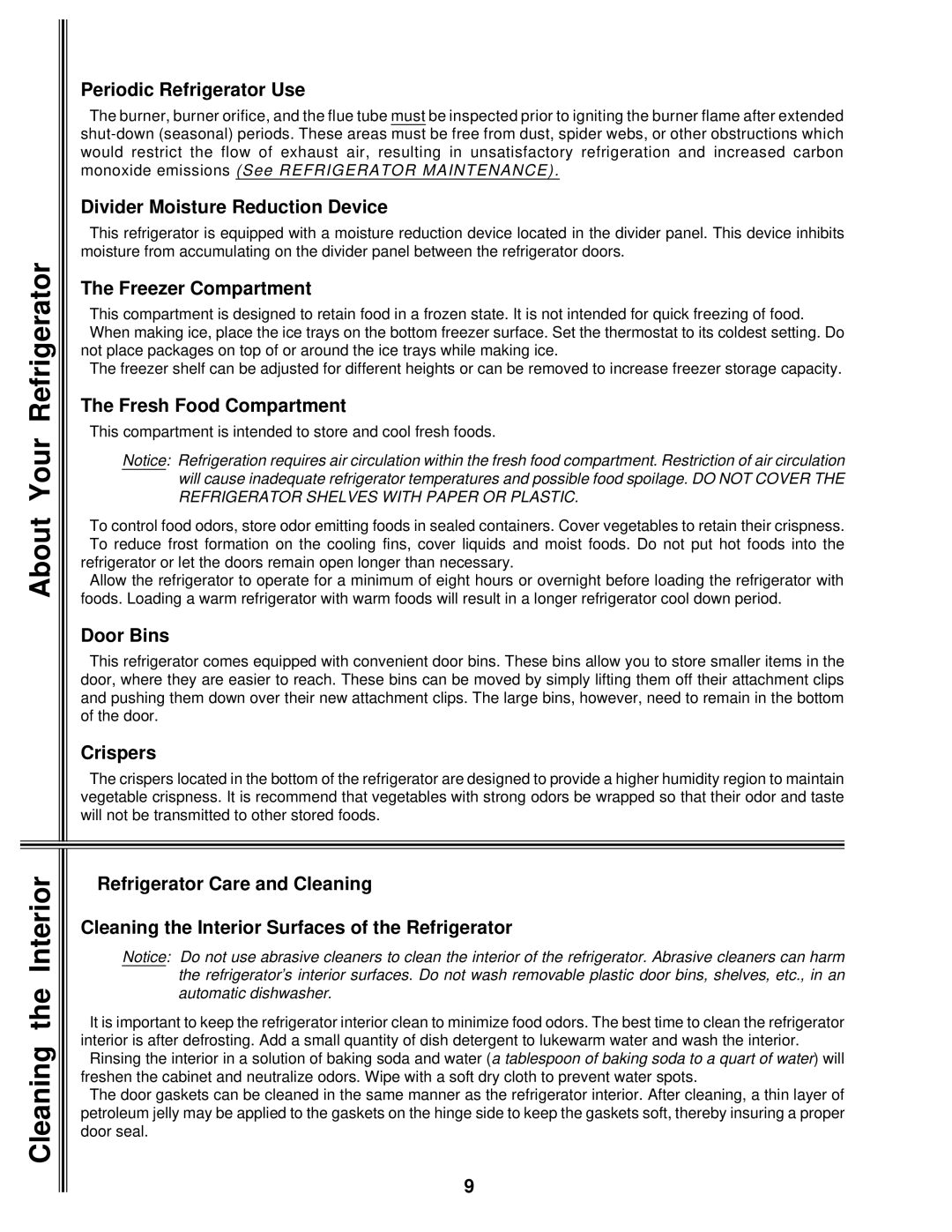About Your Refrigerator![]()
![]()
![]()
Periodic Refrigerator Use
The burner, burner orifice, and the flue tube must be inspected prior to igniting the burner flame after extended
Divider Moisture Reduction Device
This refrigerator is equipped with a moisture reduction device located in the divider panel. This device inhibits moisture from accumulating on the divider panel between the refrigerator doors.
The Freezer Compartment
This compartment is designed to retain food in a frozen state. It is not intended for quick freezing of food. When making ice, place the ice trays on the bottom freezer surface. Set the thermostat to its coldest setting. Do
not place packages on top of or around the ice trays while making ice.
The freezer shelf can be adjusted for different heights or can be removed to increase freezer storage capacity.
The Fresh Food Compartment
This compartment is intended to store and cool fresh foods.
Notice: Refrigeration requires air circulation within the fresh food compartment. Restriction of air circulation will cause inadequate refrigerator temperatures and possible food spoilage. DO NOT COVER THE REFRIGERATOR SHELVES WITH PAPER OR PLASTIC.
To control food odors, store odor emitting foods in sealed containers. Cover vegetables to retain their crispness. To reduce frost formation on the cooling fins, cover liquids and moist foods. Do not put hot foods into the
refrigerator or let the doors remain open longer than necessary.
Allow the refrigerator to operate for a minimum of eight hours or overnight before loading the refrigerator with foods. Loading a warm refrigerator with warm foods will result in a longer refrigerator cool down period.
Door Bins
This refrigerator comes equipped with convenient door bins. These bins allow you to store smaller items in the door, where they are easier to reach. These bins can be moved by simply lifting them off their attachment clips and pushing them down over their new attachment clips. The large bins, however, need to remain in the bottom of the door.
Crispers
The crispers located in the bottom of the refrigerator are designed to provide a higher humidity region to maintain vegetable crispness. It is recommend that vegetables with strong odors be wrapped so that their odor and taste will not be transmitted to other stored foods.
Cleaning the Interior![]()
![]()
![]()
Refrigerator Care and Cleaning
Cleaning the Interior Surfaces of the Refrigerator
Notice: Do not use abrasive cleaners to clean the interior of the refrigerator. Abrasive cleaners can harm the refrigerator’s interior surfaces. Do not wash removable plastic door bins, shelves, etc., in an automatic dishwasher.
It is important to keep the refrigerator interior clean to minimize food odors. The best time to clean the refrigerator interior is after defrosting. Add a small quantity of dish detergent to lukewarm water and wash the interior.
Rinsing the interior in a solution of baking soda and water (a tablespoon of baking soda to a quart of water) will freshen the cabinet and neutralize odors. Wipe with a soft dry cloth to prevent water spots.
The door gaskets can be cleaned in the same manner as the refrigerator interior. After cleaning, a thin layer of petroleum jelly may be applied to the gaskets on the hinge side to keep the gaskets soft, thereby insuring a proper door seal.
9
